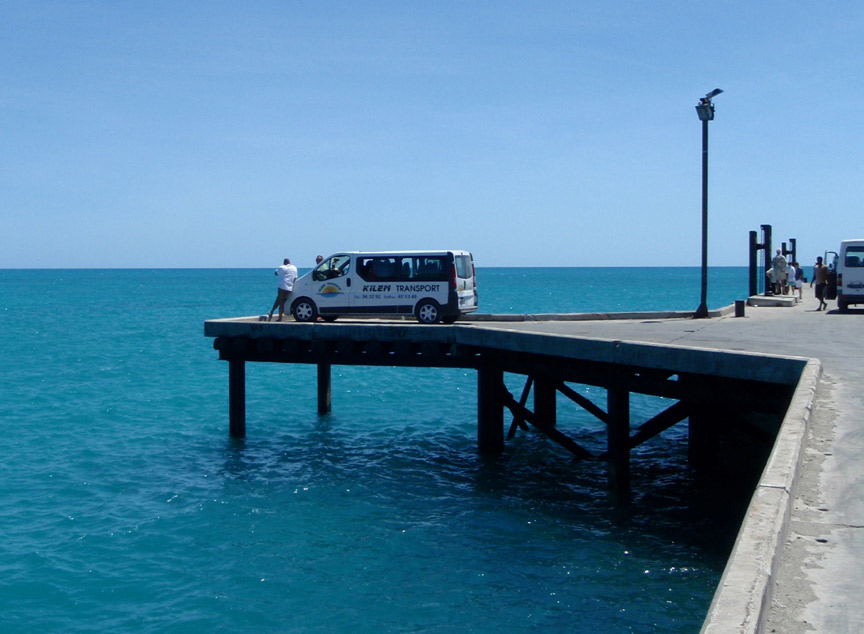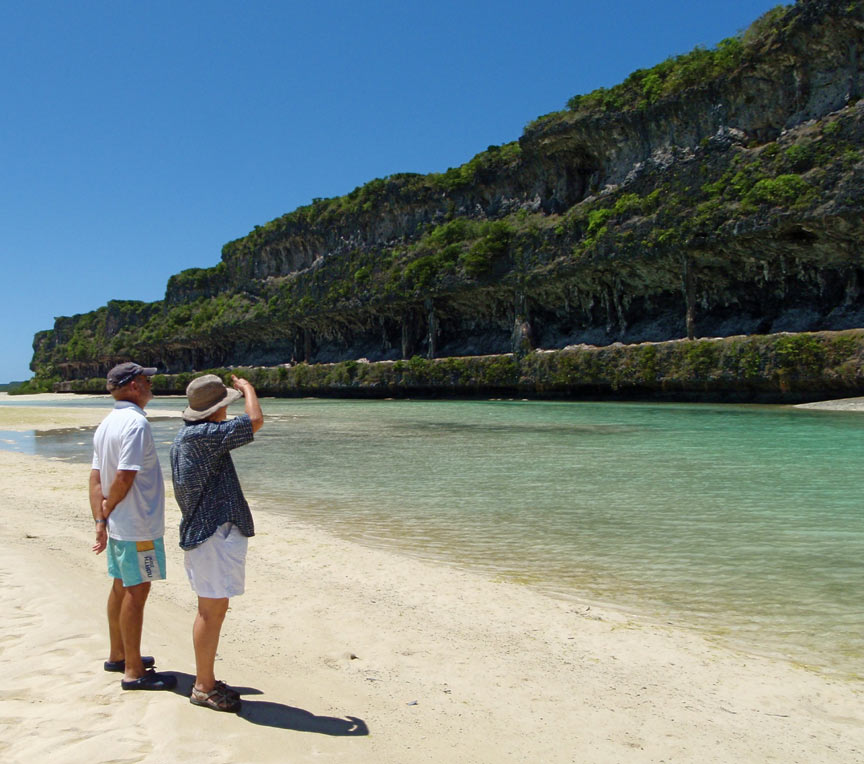Million Mile Beach and Restless Natives - Mouli Bay, Ouvea, New Caledonia

Harmonie
Don and Anne Myers
Wed 30 Sep 2009 02:24
|
20:42.985S 166:25.258E
We arrived in Mouli Bay, Ouvea on September 28th
and stayed until October 2nd.
First a little bit about New Caledonia.
Some of this is a repeat from last year, but still relevant.
New Caledonia is a French colony, a French Overseas
Territory to be exact - very similar to French Polynesia, which includes the
Marquesas, Tuamotus and Society Islands. New Caledonia is made up of four island groups. The main
island, Grand Terre, is the fourth-largest island in the Pacific, surpassed only
by New Guinea and the North and South Islands of New Zealand. The barrier
reef that surrounds Grand Terre encloses the largest lagoon in the
world. The Loyalty Island group is situated about 80 miles to the
east of Grand Terre, and is made up of two raised coral islands, Lifou and
Mare and one coral atoll, Ouvea. There is another small island group to
the north of Grand Terre and a fourth to the south called the Ile des Pins, or
for non-French speakers like us, the Isle of Pines.
Like Vanuatu, New Caledonia was originally
populated with Melanesians, but over time they have mixed with the French and
Polynesians more than the Vanuatu people have and as a result, look slightly
different. Captain Cook was the first westerner to discover New Caledonia,
but the country became a French colony in 1853. Starting in 1864, New
Caledonia was used by the French as a penal colony, so many of the original
French settlers were convicts. This went on until 1897.
The story here is similar to that of most South
Pacific island groups. The native population was decimated by diseases
brought by the westerners, and as more westerners settled in the area, the
natives were pushed off their lands, into compounds and didn't receive equal
rights to the French until 1946. Currently, New Caledonia's population is
43% native, 37% European and the rest a mix of Polynesian, Asian and other
Pacific Islanders.
Unlike many of the South Pacific islands, New
Caledonia has a very valuable natural resource - one of the largest nickel
deposits in the world. This, along with lots of money from the French, has
made New Caledonia infinitely more prosperous than Vanuatu, which has no great
natural resource and is a struggling independent nation. From what we
saw last year and so far this year, the people of Vanuatu still seem
happier than those of New Caledonia. Ouvea, which has a mostly native
Melanesian and Polynesian population of 4,360, has good roads, power lines
that run coast to coast and a regular stream of supply ships and passenger
ferries as well as a decent airport. We didn't necessarily feel
welcome here though. The people are not overly friendly and certainly
no canoes came out to greet us. To cap it off, a couple on one of the
rally boats rented a car and left it overnight on the side of the road near
the beach closest to all the anchored boats. The next
morning when they went in to shore, they found that all four tires on
the rental car had been slashed and all the gas had been drained from the
tank. This kind of thing would never happen in Vanuatu (and not just
because most Vanuatu islands don't have cars or roads). In Fiji or Tonga
it probably wouldn't happen either - certainly not on a remote island like
Ouvea.
There is a constant undercurrent of unrest in New
Caledonia as many of the native people want their independence from
France. After a long period of heightened unrest and some rioting in the
1980's and '90's, France agreed to 'a 15 to 20 year period of growth and
development culminating in a referendum on independence' (or so the Lonely
Planet guide says). 15 to 20 years have passed since then and there has
been no referendum on independence. Our own cynical view is that France
won't let New Caledonia go as long as there is still lots of nickel to be
had. The other side of it is that if New Caledonia ever did succeed in its
quest for independence, Pacific island nation history would
say that prosperity would be the first casualty. Followed
closely by crumbling infrastructure and political corruption.
Depressing yes, but probably true. However, the people might indeed be
happier. The Melanesian and Polynesian people anyway. Not so
sure about the descendents of the French convicts or other people of European
descent that have been living in New Caledonia for several
generations.
On that happy note, it's time to move on to the
wonders of Ouvea. Like its beach. Thirteen miles of uninterrupted,
glorious white sand. It may be the longest beach we've ever seen, and
that's saying a lot given the number of Caribbean and Pacific islands we've
visited so far. Ouvea's lagoon is like the best of the Tuamotu and Society
Island lagoons - twenty shades of blue that change slightly depending on
the height of the sun and cloud cover, but always cause you to stop
what you are doing to stare. Incredible.
After the excitement of the tsunami warning, we
took part in a bus tour that took us around two of the islets that
make up the chain that form the atoll Ouvea. Below are
pictures.
Picture 1 - Aside from the 30 rally boats shown at
anchor in this picture, there were very few other boats in the area. Note
the white sand. Now imagine 13 miles of it.
Picture 2 - This is a view of the lagoon within the
lagoon. It is a sacred place for the natives, so we were not allowed to
walk along the beach or swim in this area. The color of the water in the
small lagoon was even more brilliant than that of its larger
cousin.
Picture 3 - Three buses like this one were used to
tour us boaters around Ouvea. This one was owned and operated by a company
called 'Kilem Transport'. In Bislama that would mean 'kill'. It
doesn't mean 'kill' in French, but we still chose not to ride in it -
especially not on the narrow wharf. Speaking of the wharf, this is the
most substantial, well-maintained wharf we have seen since.....well since New
Zealand. We are so used to the crumbling concrete variety that this one
seemed out of place.
Picture 4 - Jackie posing for Michael on the
limestone shore where the Ouvea lagoon meets the Pacific Ocean.
Picture 5 - John and Sue admiring the
limestone cliffs formed during two separate earthquake events that happened in
the distant past. The caves on the other side of the cliffs are still used
as burial grounds for Ouvea's chiefs and are considered
sacred.
Picture 6 - In 1987 an unfortunate event
happened during a particularly bloody period of New Caledonian history. A
group of independence minded natives on Ouvea had a disagreement with the French
government and in protest, took 20 Ouvea policemen as hostages,
killing four of them in the process. Soldiers were sent to
Ouvea to remedy the situation. They freed the hostages, but killed 19
natives. All parties are now reconciled, but the incident with the
rental car makes you wonder is all is really well on Ouvea. This is a
picture of the memorial to the 19 native New Caledonians that were
killed.
More on our travels to the Isle of Pines
and capital city of Noumea later.
Anne |





